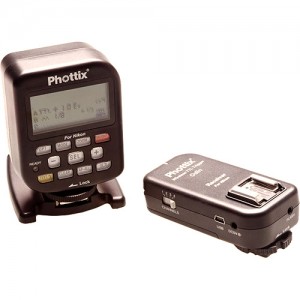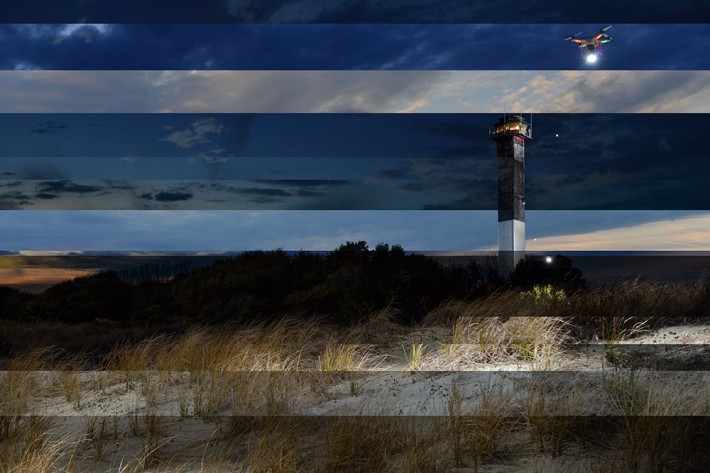As a photographer, I'm always looking to capture something in a unique way. This is the craziest landscape photoshoot I have ever done. By taping a tiny Nikon Flash to my DJI Phantom II Drone, I was able to fly my remote helicopter up the side of a lighthouse and light the entire thing with flash. Creating this photograph was one of the trickest shoots I've ever done, and this is how I made it happen.
When it comes to compositing in Photoshop I usually would try to avoid it as much as possible. Truth be told, I was just never that good at blending multiple frames together in a realistic way. Now I feel forever indebted to real estate and architectural photographer Mike Kelley after he taught me a bunch of easy ways to composite multiple exposures together using his "Mike Kelley Flash Technique". I literally use this technique all the time now. After watching Mike work in person on a few interiors I began to think, "how could I take this style of lighting to an extreme?" Naturally I began brainstorming a few project ideas I had floating around.

For the last month or two we have been producing a ton of videos featuring the DJI Phantom II like this video taken in the Bahamas. It's literally one of the most fun "toys" I've ever owned. For the longest time I have wanted to photograph a historic landscape in Charleston and apply this flash light painting technique. One of the most iconic landmarks in Charleston is the Sullivan's Island Lighthouse so I knew it would be an awesome candidate for this test.
 Mounting a speedlight to a quadcopter as small as the DJI Phantom is not an easy task. First off, the flash has to be extremely lightweight in order to keep the helicopter stable in flight. That meant all our SB-800s, 910s, and even smaller 700s were not going to work. Another obstacle I had to solve was not only finding a lightweight flash but finding a flash that could also be controlled manually since the distance from helicopter to lighthouse would most likely not be consistent shot by shot. Luckily the Nikon SB-300 fit the bill perfectly....well sort of.
Mounting a speedlight to a quadcopter as small as the DJI Phantom is not an easy task. First off, the flash has to be extremely lightweight in order to keep the helicopter stable in flight. That meant all our SB-800s, 910s, and even smaller 700s were not going to work. Another obstacle I had to solve was not only finding a lightweight flash but finding a flash that could also be controlled manually since the distance from helicopter to lighthouse would most likely not be consistent shot by shot. Luckily the Nikon SB-300 fit the bill perfectly....well sort of.
 The Nikon SB-300 does not have manual control but it does use Nikon's iTTL system. In order for me to control the output of the flash, I was going to have to sync my camera and flash with a wireless radio trigger that worked with iTTL. My trigger of choice is the Pocket Wizard Plus III triggers but they cannot control flash output. Therefore, I had to try this shoot with another radio system. The Phottix Odin wireless system is designed to give you control of your Nikon flashes directly from the transmitter on your camera's hotshoe. It was an added bonus that the Odin receiver made it easy to mount both the receiver and the flash directly to our quadcopter with little more than some electrical tape.
The Nikon SB-300 does not have manual control but it does use Nikon's iTTL system. In order for me to control the output of the flash, I was going to have to sync my camera and flash with a wireless radio trigger that worked with iTTL. My trigger of choice is the Pocket Wizard Plus III triggers but they cannot control flash output. Therefore, I had to try this shoot with another radio system. The Phottix Odin wireless system is designed to give you control of your Nikon flashes directly from the transmitter on your camera's hotshoe. It was an added bonus that the Odin receiver made it easy to mount both the receiver and the flash directly to our quadcopter with little more than some electrical tape.
Once we had the quadcopter flying, I began directing Lee Morris as to where I wanted him to fly the copter for the best light. Overall I took over 200 photographs with half of those being frames exposed for the flash and half of them being bracketed images of the natural sunset light. Overall I think I used about 25 unique frames to build my final composite. In this sort of situation, it's best to over shoot and over bracket so that when you get back to the computer you are 100% positive you have all the images needed to make the composite work. Here is a fun little image I made showing different exposures throughout the entire process.
Once I started photographing the lighthouse, I began to think it might be cool to make the foreground look like it was being illuminated by the lighthouse itself. I wanted some of the foreground to be dark while part of it to be bright. In order to bring everything together in a coherent way, I used Aaron Nace's "How to create beams of light" Photoshop technique. Aaron is an extremely talented photographer, retoucher, and educator, and I'm excited to say he is going to be teaching a few workshops at our 2014 Fstoppers Workshops in the Bahamas this May. Here is the video that helped me achieve a realistic beam of light for the final lighthouse composite.








amazing, you just changed the game forever... i feel like this is going to be the future of a lot of good things to come :) thank you for the idea... :) if i use it ill link it back
OH MY GOD you have just pushed me over the line. I AM BUYING THE DRONE AS I TYPE
That was very cool! Now I want a drone...
Dat ass on the front page tho.
I'm hustling my workshop game for the sole purpose of becoming a drone pilot. :3
Like a boss! But seriously...love the vision and the process to make it work.
Awesome final image!
Killed it. Awesome job guys.
AWESOME!
very nice... thank you
Brilliant!
this is simply the best use for a drone in photography I've ever seen, the image is perfect, thx for sharing
There no doubt about it, it worked... But one would have to ask, why would you go to all the issues of drones, remote commanders and so many layers, whereas you probably could have done this with a Brinkman Q-Beam and a snoot, and 10 shots layered? We've used handheld powered spotlights to shoot time exposures since 1984.
I'm not knocking this in anyway, shape or form.. Just questioning the complexity of it.
How would I have gotten light angled down? The whole top of the light house is lit from above.
You can just have Lee jump! A running start might be advisable, though.
Duh Patrick. You skydive in. A lot.
How did you come back the next day and ensure you had the same position and framing? Or did you have to tweak quite a bit in post?
The picture was completely re-shot. Nothing from day one was used in the final image.
Ah, thank you. That makes sense. For some reason I interpreted it as Patrick just going back to get a better sky.
Nope, went back the next day for the whole setup. Everything you see was taken within 90 minutes on one single night.
Scanning......yup, confirmed. Rad.
WTF!!! How many layers did you end up with? Awesome image. I'm still trying to wrap my head around all the different things you did.
Hey great Lighthouse image! I understand that you guys are bracketing exposures for ambient light periodically, but are you also "bracketing" flash pops as well? i.e. multiple flashes on the same basic position at varying powers?
Very unique use of the drone. Has to be a first. Great composite.
Hell yeah
Looks like lots of fun - but can't help think that similar results could have been achieved by combining daytime, dusk and night shots of the scene with masking/dodging and burning - without all that flash/drone work.
I really don't think it would be possible. To light the right side of the light house you would have to be there early in the morning for sunrise. Some of the detail like the area around the red paint at the top would probably never get light from that direction. Also the way the shoot was executed, it allowed me to flash the intricate rails, towers, antennae at the top against a near black background. Doing that during the day would make it very very hard to separate those details from a bright background.
Also many of the light pops in the foreground are coming from a direction that would not be seen by natural sunlight. The sun would have risen and set from the right to the left but behind the camera....so having shadows coming towards the camera would not be possible.
I have been wanting to do something like this for a while but just don't have the funds to buy myself a decent tablet atm never mind a drone :)
Keep up the good work :)
Inspiring -- thank you for sharing! I just taped a speedlite to mine and am looking forward to giving this a try :)
Wouldn't be easier if you just lightpainted it with a flashlight?
You couldn't light the lighthouse from the ground with a flashlight. Much of the light is coming from a parallel location or even above shooting down. You might be able to light the foreground with a flashlight but you would have to mount it to a light stand that is about 10-20' high to get the shadows the cast downwards.
I understand you can not get the light angle down naturally, but, by shadows casting downwards you mean the dark side of the lighthouse? My idea is, couldn't you light-paint everything and then darken/create the shadows on photoshop after? Since you are doing a lot of photoshop anyways :)
Love how i thought of this 2 years ago but couldnt efford to do so now some one has the lime light
Can't make excuses; you gotta pull the trigger when the ideas hit. I've had the same thing happen to me before. I'm focusing more now on doing ideas in my head than talking about doing them. Everyone talks, few do.....and I believe that is what separates success from failure more than anything.
Hi guys I know this is an old post, but I am having some technical difficulties. I have the exact same equipment used in this shoot, specifically the cam ranger and the phottix Odin system. I have recently noticed that when firing the camera remotely, it takes a couple shots to get the Odin to fire the flashes. Is this some type of setting? Is the camera or Odin transmitter going idle? I have noticed that it will keep working if I shoot constantly over and over. But if I wait more than 20-30 seconds between shots, this behavior will repeat itself. Any ideas?
Awesome use of a Drone, congratulations!
Also loved the music bed. Mind sharing the source?
Best
Did you pull out the camera unit from the drone and add the flash light and the remote receiver?